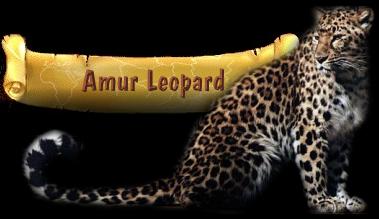

Amur Leopard - Page 1&2:
In The Wild | 3&4:
In Captivity | 5&6:
Subspecies Description |
7:
Weight & Length Figures | 8&9:
Conservation
Amur leopard pelage:
Of all the leopard subspecies, the Amur wears the most interesting coat. This is reddish-yellow in summer, becoming pale cream during the winter months. It varies in length from 2.5 cm to 7.5 cm, depending upon the time of year and weather conditions. Across the back, flanks and upper limbs are widely spaced rosettes which are darker at the centre and have thick borders. Small spots appear on the head, becoming larger on the legs and abdomen. "How the leopard got its spots":Within his 'Just So Stories', ( "How the Leopard Got its Spots") Rudyard Kipling recorded the explained the camouflage benefits of the leopard's coat: "Now you are a beauty!" said the Ethiopian. "You can lie out on the bare ground and look like a heap of pebbles. You can lie out on the naked rocks and look like a piece of pudding-stone. You can lie out on a leafy branch and look like sunshine sifting through the leaves; and you can lie right across the center of a path and look like nothing in particular." |
A long-legged leopard:Along with coat length, the Amur leopard has another adaptation for the wintry climate in which it lives. Of all the leopard subspecies this one has the longest legs, presumably to make walking in snow much easier. Differences between leopards and jaguars:People often confuse leopards and jaguars (Panthera onca). There are definite differences between the two cats, but these are not terribly obvious just from photographs. These cats are thicker, stockier and heavier than leopards, weighing in the region of 120-240 pounds. Some males reach weights of 300 pounds and the jaguar is the world's third largest naturally breeding cat, falling just behind the tiger and the lion. For comparison, the weight of an Amur leopard ranges from 62-198 pounds. Jaguar
coat patterns are slightly different from the leopard in
that the rosettes are set further apart than on the leopard and
it is more common for them to form unbroken rings. Melanistic or black leopards and jaguars:Melanistic cats have a black background colour; in the case of leopards or jaguars they still have spots, but the dark coat base colour makes these difficult to discern (these can be seen in the cub on the left). Melanistic leopards and jaguars occur within normal litters and are often referred to as black panthers. Melanism also occurs in Bengal tigers, though it is extremely rare. A melanistic jaguar is pictured on this page. Note the thick neck. Jaguars are particularly muscular around this area of the body. The usual spots show with the correct angle of reflection under bright sunlight. Albinistic (white), erythristic (red), and several other coat colours also occur in the leopard family. Further information on various cat colourations and colour photographs of these special cats can be found off the Main Menu. |
|
Amur Leopard
- Page 1&2:
In The Wild | 3&4:
In Captivity | 5&6:
Subspecies Description
| Amur | Bali | Bengal | Caspian | Corbetts | Javan | Sumatran | South Chinese | Amur Leopard |
|
Photography
With Thanks To The Feline
Conservation Center. |